Throughout the evolution of the Hoax, Durham’s interim District Attorney, Mike Nifong, has shown himself to be a man willing to accept as truth the statements and arguments which best suit his preferred theory of the moment. He has demonstrated this willingness by selectively picking and choosing to accept the “facts,” “evidence,” and arguments that best suit his immediate needs, without regard to either the validity of those items, nor opposing truth that contradicts his choices. Rather than as a minister of justice seeking the truth, DA Nifong has apparently approached this hoax as if it were his own private trough at the Old Country Buffet.
When needing a non-testimonial DNA order, the argument was that there was strong physical evidence that would allow DNA testing to identify suspects and exonerate the innocent. When two rounds of DNA testing revealed only a match to a person other than the members of the lacrosse team, the argument became, “How does DNA exonerate you?” The science of DNA went from all-important to meaningless in the time it takes to say, “Matthew Murhison.”
The alleged assault endured for brutal 30 minutes when it was time to secure warrants, and to inflate Nifong’s primary election prospects. It apparently remained 30 minutes when it was necessary to sell the hoax to the grand jury. When an alibi for one of the defendants was revealed, 25 minutes evaporated and the duration became five minutes.
When needing to explain the discrepancy in time, “Dr.” Nifong’s argument was that when something really bad happens, it might seem like a longer stretch of time. When it was convenient in this manner, the accuser’s memory was distorted by trauma. On April 11th, the accuser was still too traumatized to discuss the case with Nifong, yet on April 4th she was able to identify four of the three (yes, four of the three) alleged assailants. Better yet, while arguing to secure the payment for toxicology testing, Nifong vouched for the accuser’s ability to recall the event in great detail.
The suspects were named Matt, Adam and Brett, until the accuser failed to identify them in six photographic arrays. The suspects then become unknown, and the new truth became a fake name theory.
At one time, Nifong opined that an intoxicated accuser might be more credible. Later he argued that it was her lack of intoxication that suggested a drug was employed. A date rape drug theory was floated initially. Later this date rape drug became ecstasy. Eventually it became nothing as testing disproved the possibility.
When looking for an endorsement, Nifong claims that he is confident in his case because he has interviewed the accuser. When in court and presumably needing to hide the details of his conversations with the accuser, Nifong tells the judge he has not spoken to her about the details of the case.
We could go on with the examples of how Mr. Nifong has refilled his tray, when his initial selection no longer fit his appetite for continuing the illusion that he had reason to pursue his case. Trusting that the point has been made, we turn our attentions to Nifong’s possible motivation. At the end of the day, Mr. Nifong looks at himself in the mirror and apparently does not see the pariah he has become to many.
There has been much speculation about what drives District Attorney Mike Nifong to blatantly disregard all evidence that contradicts the notion that a crime (other than the filing of a false police report) occurred in the Duke Hoax. There appears to be two prevailing schools of thought among legal scholars as to what causes a prosecutor to dine at the buffet of truth. The first possibility is that Nifong suffers from misconduct inducing Tunnel Vision that blinds him to all truth that contradicts his preconceived notions. The second is a more ominous theory referred to as Conviction Psychology, which ascribes an ambitious need to win (conviction, election etc.) as the motive for misconduct.
Tunnel Vision
University of Wisconsin Law Professor Keith Findley, who serves as the Co-Director of the Wisconsin Innocence Project, notes that prosecutorial and police tunnel vision is one of the most common denominators in each of the cases where DNA evidence has led to the exoneration of wrongfully convicted men and women. As with other factors characterizing wrongful convictions that we have previously examined, it appears that District Attorney Mike Nifong’s approach to the Duke Hoax would make a perfect case study for the dangers of tunnel vision by a prosecutor.
In
an essay written for the Innocence Project, Professor Findley notes:
“Tunnel vision is a well-recognized phenomenon in the criminal justice system. Most of the official inquiries into specific wrongful convictions have noted the role that tunnel vision played in those individual cases of injustice.”
“The 160-plus post-conviction DNA exonerations of the last 15 years have exposed numerous problems that have contributed to convicting the innocent. One commonality in almost all of the cases, however, is that they feature some form of tunnel vision.”
“Tunnel vision is the process that leads investigators, prosecutors, judges, and defense lawyers alike to focus on a particular outcome, and then to filter all evidence in a case through the lens provided by that outcome. Through that filter, all information that supports the adopted outcome is elevated in significance, viewed as consistent with the other evidence, and deemed relevant and probative, while evidence inconsistent with the chosen theory is easily overlooked or dismissed as irrelevant, incredible, or unreliable.”
Is it possible that Nifong has disregarded the truth, as it stared him in the face, repeatedly, because his tunnel vision allowed him to reject any truth that would not conform to his preconceived notion of what the truth was? It appears that rather than consider exculpatory evidence, he either ignores it, or attempts to diminish its value by changing his theory of the case, or spinning it away.
When the scientific testing conducted by the SBI and a private lab revealed that the results of the DNA tests pointed to the accuser’s boyfriend as the only possible “suspect,” he immediately disregarded the value of DNA testing. Rather than consider that the science of DNA had just exonerated the entire team, and despite his previous confidence that with an assault as described by the accuser there could not have been no traces of her attackers left behind, he willingly chose to discount the value of DNA testing. To justify the absence of DNA, Mr. Nifong altered the theory of the case from each of its retellings by the accuser to a contradictory version that introduced the possibility that condoms and/or objects could have been used. This willingness to alter even the accuser’s version of events to construct a pursuable theory that also defies scientific results appears to be the epitome of tunnel vision.
Insertion of facts not in evidence such as condoms and objects is not the only instance of Mr. Nifong’s tunnel vision, allowing him the luxury of inventing his own reality. While the accuser details a thirty minutes attack, Mr. Nifong imagines a five minutes time frame designed to argue against an alibi bolstered by independent witnesses, electronic evidence, photographs and more. With Nifongian blinders on, he fails to accept any and all evidence that does not conform to his delusional reality. The arguments he presents contradict nearly all the evidence in his own case files, yet he refuses to accept that he is persecuting innocent men for a crime that did not happen.
As time goes on, the public trust normally afforded a person in his position erodes, and the benefit of the doubt is expended. Save die-hard apologists such as Bob Ashley, John Bourlon and a few others, Mr. Nifong’s ridiculous submission to his own tunnel vision becomes more readily apparent with each new revelation that contradicts the theories he has put forth before. His expectation of a date rape drug has been proven false. His manufactured lineup has been revealed to be not only a sham, but also an exercise in futility, as the accuser misidentifies bystanders, selects one more perpetrator than she claimed, and identifies with certainty someone who was not at the party as being there. With every twist and turn of the Hoax, it becomes clearer that Nifong refuses to accept or consider any fact that belies his preconception.
“One particularly disturbing theme that recurs in many of these cases is the refusal of prosecutors to concede that the wrong person was convicted, even after a defendant’s exoneration. This refusal is highly troubling for a host of reasons. For the defendant who may have spent years in prison, or even on death row, it deprives him of the simple apology to which he seems entitled. It also deprives the public at large of an apology - for the failure to pursue the real culprit, who in many cases has been left to commit additional crimes;6 for the misdirection of public resources; and, in general, for participating in a miscarriage of justice.”
“But, there are more pragmatic problems as well. First, the refusal to accept that an injustice occurred is often preceded by the refusal to admit to problems with the case or to remain open to additional evidence during the investigative stage of the case.”
Mr. Nifong’s refusal to even meet with defense attorneys, his unwillingness to view exculpatory evidence, and his flippant attitude towards the possibility that the defendants might be truthful appear to define the characterizations presented by Prof. Bandes.
Conviction Psychology
While it may appear, at a glance, that Mr. Nifong merely suffers from the easily recognizable tunnel vision that is prevalent in the cases of wrongful prosecution, one must consider his multiple inflammatory public statements, his refusal to view exculpatory evidence, and the timing of his indictments in relation to the election.While we see clearly that Mr. Nifong’s conduct defines prosecutorial tunnel vision, is there another motivating factor that is prevalent in cases of prosecutors gone wild?
"Legal analysts usually rely on either a so-called tunnel vision or a conviction psychology explanation for prosecutorial misconduct…This mentality [conviction psychology] stems from institutional, professional, and political pressures to win convictions. For example, district attorneys (DAs) feel pressure to convict because voters use convictions as a quantifiable measure of success when choosing a DA candidate. Legal analysts argued that the desire to win convictions, coupled with limited sanctions for misconduct, can lead to misconduct.”
Regardless of whether Mr. Nifong is helpless to escape the tunnel vision that causes him to willfully disregard all truth that does not conform to his perception, or whether Mr. Nifong manipulatively ignores and distorts the truth in pursuit of elected office, the results remain the same. Three innocent men stand charged with a crime that never occurred, while Mr. Nifong continues to be the human case study in prosecutorial misconduct.
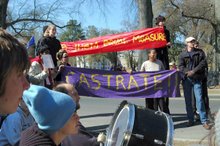




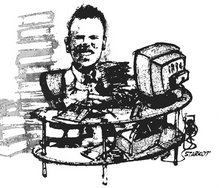
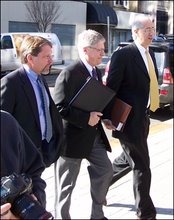
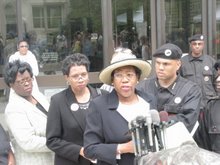
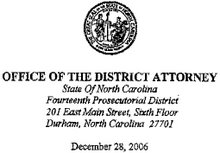
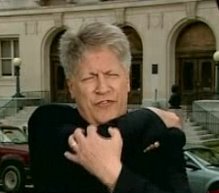

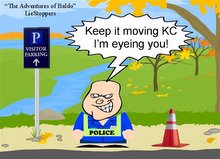

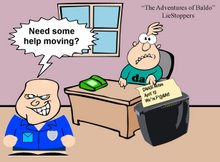

















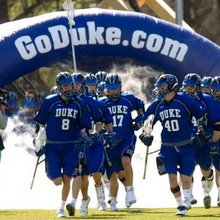

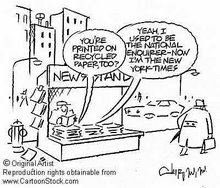


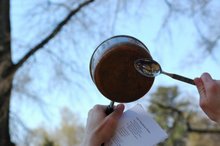

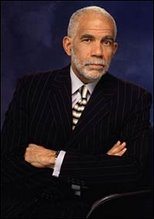
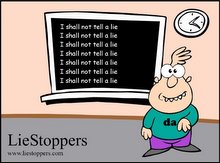






4 comments:
I have been following the MSM and blogs regarding the Duke case since May. I have been left with the distinct impression that "something stinks in the state of (Durham)." Having no professional legal background and residing in Massachusetts, my interest does not carry the weight of a resident of NC. A question I have is this... Nifong has played "pop psychologist" at least twice in this case: i.e. the accuser misidentified the amount of time of alleged assault took place because "when something bad happens to you, it seems to take longer that it actually did." He also stated that the accuser was "too traumatized" on April 11, 2006 in an interview with authorities to discuss the case. I wonder if this is more of Nifong's psychology background coming out. Is it possible that the accuser indicated her desire to recant her statements regarding the rape, and when faced with the loss of all his eggs in the one basket, Nifong reacted by saying that the accuser must be too traumatized by the event, and this mental state renders her incapable of making sound decisions regarding her involvement in the case. I don't mean to be a "second shooter" theorist, but I have been wondering about this. If the accuser did attempt to recant her accusations, and this meeting was recorded and those notes exist, Nifong would want those notes suppressed permanently. So, Nifong claims those notes do not contain any statements from the accuser regarding the case, only trial procedure and "work product" information. Just a thought. Keep up the good work all you bloggers. I would appreciate any input on my supposition.
Beth Sweeney
Lowell, MA
Frankly I prefer that the DA and Law enforcement be focused - tunnel vision as generally understood is fine in the adversarial legal system as it is established in the US.
Nifong has gone way beyond what we generally understand as tunnel vision -- he abused his office for political gain without regard to the most preliminary effort to "fact find".
I would contend in normal circumstances where a DA does have a solid factual basis to proceed to trial (not the Duke hoax) that they do so with great rigour.
How do you legislate DA ethics ?
Answer: At the voting booth - be sure to show up
Here is a quote from KC Johnson's "Durham in Wonderland", which for me sums up the sentiment in Durham:
"John Bennett, a black pastor in Durham, criticized 60 Minutes for interviewing Kim Roberts (on the grounds, oddly, that Roberts has changed her story—in an affair where the accuser has offered multiple versions of events). Said the pastor, “Hopefully, justice is blind when it is time to carry out the proper punishment for what has been committed, and perhaps what has not been committed.”
The last clause brough back memories of Chan Hall, the NCCU junior who proclaimed that he wanted the Duke players prosecuted “whether it happened or not. It would be justice for things that happened in the past.”"
Not only is there a presumption of guilf for the accused, but they are now to be punished for the sins of others.
The DA is not the only one with tunnel vision.
Please read your posts and eliminate typos prior to posting.
Post a Comment